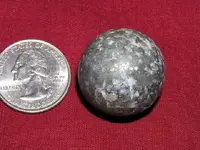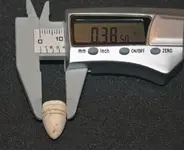Petrie502,
The many Internet forums have rapidly gained popularity in recent years, for exchanging information and seeking properly attributed provenance for artifacts and relics. With the ability to search vast archives simply with keywords and photo reference, quite often these discussions are accessed at later dates, and used once again to prove or disprove theories and identifications.
This particular thread here on "Copper Cannonballs" came back to light yesterday, after more than a year of dormancy (original thread was started in 2011, and prior recent activity was June of 2012), whereupon a new member here posted a query on an unrelated iron ball, seeking hopeful identification. TheCannonballGuy provided a helpful and informative response for the newly posted inquiry.

The points brought out there, are all ones I certainly concur with wholeheartedly (Welcoming a new poster, proper etiquette in beginning a new topic on a new thread, importance of proper measurements and weights, etc..).
My respect for the invaluable knowledge and polite explanations provided free of charge by great members here like TheCannonballGuy, surely cannot be overstated.

Knowing though, that often these discussions may be referenced in coming months and years by untold individuals far across the globe, and possibly utilized to once again add hopefully properly attributed identification to items, instills within my heart a steadfast devotion to provide the best accurate identifications when and where possible. Furthermore, when noticing possible discrepancies that could be mistakenly taken as fact at some point, one surely must take the honorable approach and politely address these for clarity.
The only "correction" that was offered in my earlier response, was to enlighten that North America
includes Mexico, and any statement addressing "North America" in whole, can and will technically encompass all parts and areas therein.

Also, since the earlier discussion involving "copper cannonballs" principally discussed recoveries in and around Mexico, and use of smaller "cannister balls", my point was to expound upon the fact that additional examples of
larger size copper balls (possible cannonballs rather than cannister balls) have been noted. Furthermore, the confines of geography by no means end at the current borders of Mexico, as there have been similar artifacts found on numerous occasion within California (part of the Republic of Mexico prior to the Treaty of Hidalgo in 1848).
CC Hunter 









